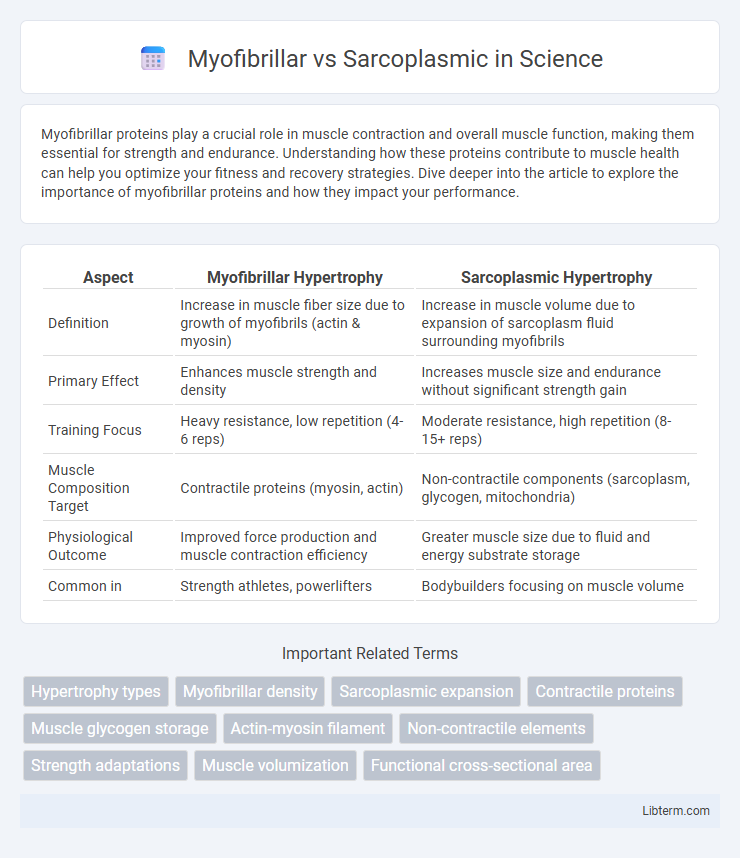Myofibrillar proteins play a crucial role in muscle contraction and overall muscle function, making them essential for strength and endurance. Understanding how these proteins contribute to muscle health can help you optimize your fitness and recovery strategies. Dive deeper into the article to explore the importance of myofibrillar proteins and how they impact your performance.
Table of Comparison
| Aspect | Myofibrillar Hypertrophy | Sarcoplasmic Hypertrophy |
|---|---|---|
| Definition | Increase in muscle fiber size due to growth of myofibrils (actin & myosin) | Increase in muscle volume due to expansion of sarcoplasm fluid surrounding myofibrils |
| Primary Effect | Enhances muscle strength and density | Increases muscle size and endurance without significant strength gain |
| Training Focus | Heavy resistance, low repetition (4-6 reps) | Moderate resistance, high repetition (8-15+ reps) |
| Muscle Composition Target | Contractile proteins (myosin, actin) | Non-contractile components (sarcoplasm, glycogen, mitochondria) |
| Physiological Outcome | Improved force production and muscle contraction efficiency | Greater muscle size due to fluid and energy substrate storage |
| Common in | Strength athletes, powerlifters | Bodybuilders focusing on muscle volume |
Understanding Muscle Growth: Myofibrillar vs Sarcoplasmic Hypertrophy
Myofibrillar hypertrophy increases muscle strength by enlarging muscle fibers through the growth of myofibrils, the contractile units responsible for force production. Sarcoplasmic hypertrophy enhances muscle size by expanding the sarcoplasm, the fluid and energy substrates surrounding myofibrils, without a proportional increase in strength. Understanding these hypertrophy types helps optimize training protocols for specific goals, such as strength gains with low-rep heavy lifts for myofibrillar growth or muscle endurance and size with higher-rep volume training targeting sarcoplasmic expansion.
What Are Myofibrillar and Sarcoplasmic Hypertrophy?
Myofibrillar hypertrophy involves the growth of myofibrils, the contractile fibers in muscle cells, resulting in increased muscle strength and density. Sarcoplasmic hypertrophy refers to the enlargement of the sarcoplasm, the fluid and energy-storing components of muscle fibers, leading to greater muscle size without significant strength gains. Understanding these two types helps tailor training programs to prioritize either muscle strength or endurance based on specific fitness goals.
Key Differences Between Myofibrillar and Sarcoplasmic Growth
Myofibrillar growth primarily involves an increase in the size and number of myofibrils, leading to enhanced muscle strength and density, while sarcoplasmic growth focuses on expanding the volume of sarcoplasm, which increases muscle size without significantly improving strength. Myofibrillar hypertrophy is typically stimulated by heavy resistance training with low repetitions, whereas sarcoplasmic hypertrophy is driven by higher-volume training that boosts muscular endurance. Understanding these differences helps optimize training protocols based on whether strength or muscle size is the primary goal.
Molecular Mechanisms Behind Muscle Hypertrophy
Myofibrillar hypertrophy involves the molecular upregulation of contractile proteins such as actin and myosin, driven by signaling pathways including mTORC1 and increased protein synthesis that results in larger muscle fibers and enhanced strength. Sarcoplasmic hypertrophy primarily enhances the volume of sarcoplasmic fluid and energy substrates like glycogen within muscle cells, mediated by increased expression of enzymes involved in glycolysis and mitochondrial biogenesis, supporting greater muscle endurance. Both types of hypertrophy rely on differential activation of satellite cells and transcription factors, shaping muscle adaptation through distinct yet complementary molecular mechanisms.
Training Methods for Myofibrillar Hypertrophy
Myofibrillar hypertrophy training emphasizes heavy resistance with lower repetitions, typically in the 3-6 rep range, to stimulate increased muscle fiber density and strength. Compound movements such as squats, deadlifts, and bench presses are crucial for maximizing myofibrillar growth by engaging multiple muscle groups and promoting neuromuscular adaptation. Progressive overload and sufficient recovery periods ensure optimal muscle fiber recruitment and repair, enhancing contractile protein synthesis for greater force production.
Training Strategies to Maximize Sarcoplasmic Hypertrophy
Training strategies to maximize sarcoplasmic hypertrophy emphasize high-volume resistance exercises with moderate weights, typically in the 8-15 rep range, to increase muscle cell fluid and glycogen storage. Incorporating shorter rest periods between sets, around 30-60 seconds, enhances metabolic stress, a key driver of sarcoplasmic growth. Supplementing training with exercises targeting muscle endurance and using techniques like drop sets or supersets optimizes sarcoplasmic hypertrophy without significantly increasing myofibrillar contractile proteins.
Benefits and Drawbacks of Each Muscle Growth Type
Myofibrillar hypertrophy enhances muscle strength and density by increasing the size and number of myofibrils, promoting improved force production, but may result in slower muscle size gains. Sarcoplasmic hypertrophy enlarges muscle size more rapidly by increasing the volume of sarcoplasmic fluid, benefiting bodybuilding aesthetics but often offering less strength improvement. Balancing both types can optimize overall muscle development by combining strength gains with muscle size enhancement.
Myofibrillar vs Sarcoplasmic: Which Is Better for Strength?
Myofibrillar hypertrophy targets the growth of muscle fibers responsible for contraction, enhancing overall strength and power by increasing muscle density. Sarcoplasmic hypertrophy enlarges the fluid and energy storage in muscles, improving endurance but contributing less to maximal strength gains. For strength-focused training, myofibrillar hypertrophy is generally more effective due to its direct impact on muscle fiber size and contractile force.
How to Combine Both Hypertrophy Types for Optimal Gains
Combining myofibrillar and sarcoplasmic hypertrophy for optimal muscle gains involves integrating heavy compound lifts that stimulate myofibrillar growth with moderate to high-rep isolation exercises targeting sarcoplasmic expansion. Heavy sets of 3-6 reps with progressive overload enhance muscle fiber density and strength, while 8-15 reps promote increased muscle cell fluid volume and endurance. Structuring workouts to alternate between these rep ranges or incorporating periodization strategies ensures balanced development of muscle size and strength.
Frequently Asked Questions About Muscle Hypertrophy
Myofibrillar hypertrophy increases muscle strength and density by enlarging the contractile proteins, primarily actin and myosin, within muscle fibers. Sarcoplasmic hypertrophy focuses on enhancing muscle size by increasing the volume of sarcoplasmic fluid and energy substrates, improving muscle endurance without significantly boosting strength. Frequently asked questions about muscle hypertrophy often address the differences in training approaches, with heavyweight, low-repetition routines promoting myofibrillar growth and higher-repetition, moderate-weight schemes favoring sarcoplasmic expansion.
Myofibrillar Infographic

 libterm.com
libterm.com